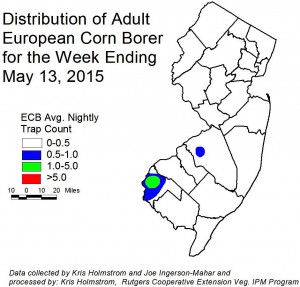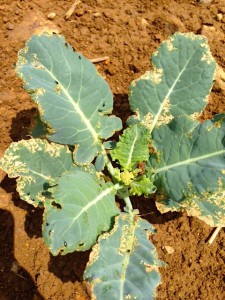Sweet Corn
The black light trap network has been deployed and is being monitored by IPM Program personnel. The corn earworm (CEW) pheromone trap network is currently being deployed. As adult European corn borer (ECB) and CEW begin to arrive in traps, population maps of these pests will be published in the Plant and Pest Advisory on a weekly basis. Additionally, maps of the brown marmorated stink bug (BMSB) will also appear in this publication.
A few European corn borer (ECB) adults have been captured in New Jersey over the past week. At this time, the highest number of moths captured has been from Salem County (see ECB map). As warmer weather becomes consistent, catches should increase across the state. Night time temperatures in the low 50°F range or lower will cause catches to develop more slowly. Larval infestations should not occur for some time yet. We will first see a significant increase in the number of traps registering catches.
The highest nightly ECB catches for the previous week are as follows:
| Woodstown 2 | Cedarville 1 |
| Beckett 1 | East Vineland 1 |
| Belvidere 1 | Eldora 1 |
No corn earworm moths (CEW) have been captured in blacklight traps in New Jersey as of this time.
Black cutworm (BCW) moths are also flying. These are the moths that will produce the seasonal first generation caterpillars that will be attacking corn plants and other crops. BCW larvae normally feed on plant stems and roots below ground level, and are more of a problem in minimum tillage fields. Soil disruption inhibits BCW development in the field.
Cole Crops
With warm, sunny days, IPM personnel have discovered a number of heavy infestations of crucifer flea beetle (see photo). These beetles can build to high populations quickly, especially where wild mustard and related cruciferous weeds are common. Extreme feeding on small transplants can cause irreversible damage if not controlled promptly.
While flea beetles may be controlled with foliar applied insecticides, it is possible to get 2-3 weeks of protection by using a soil applied systemic insecticide at planting. This insures good establishment of the transplants without significant flea beetle injury.
Soil applied materials include (active ingredient – trade name (IRAC* code)):
Clothianidin – Belay (4A)
Cyantranilaprole – Verimark (28)
Dinotefuran – Scorpion/Venom (4A)
Imidacloprid – Admire Pro (4A)
Egg laying by imported cabbage butterflies (ICW) is occurring at this time, and will continue as warm weather permits activity. Infestations of this pest have not been seen by scouts in the northern counties as yet, but are likely present in southern parts of the state. Scout plantings weekly. Check 5 consecutive plants each in 10 random locations throughout the planting, paying particular attention to the innermost leaves where ICW often feed. Consider treating if caterpillars are found on 10% or more plants that are in the 0-9 true leaf stage. From 9-leaf to the early head stage (in broccoli, cauliflower and cabbage) infestations up to 20% may be tolerated. Once heads begin to form, a 5% threshold should be observed to protect the marketable portion of the plant. For leafy greens such as collards and kale, 10% plants infested is the threshold throughout.
Although none have been discovered yet, it is not too soon to begin preparing for infestations of diamondback moth (DBM) larvae. Some populations of DBM are resistant to carbamate and synthetic pyrethroid insecticides. The lack of DBM control with these insecticides has been noted in NJ previously. It is important to distinguish between common cole crop pests for this reason. DBM larvae grow to a length of approximately 0.5”, and taper toward both ends. These caterpillars thrash violently when disturbed. ICW grow to a length of approximately 1.25” and are covered with short hairs. Newer chemistries that specifically target caterpillar pests are effective against DBM as well as all other caterpillar pests of cole crops. These materials include (active ingredient – trade name (IRAC* code)):
Spinosad/Spinetoram – Entrust/ Radiant (5)
Chlorantraniliprole – Coragen (28)
Cyantraniliprole – Exirel (28)
Flubendiamide – Synapse (28)
The IRAC group 5 insecticide, Entrust, is OMRI approved for organic production. Insecticides based on the soil inhabiting bacterium Bacilllus thuriengensis (B.t.) may also be effective on caterpillar pests of cole crops. Examples include Xentari and Javelin. These materials are also OMRI approved. If B.t. materials are used, they must target smaller larvae. Do not wait until large larvae are dominant the field, as results may be unsatisfactory. An added benefit of all the aforementioned chemicals is that they have minimal impact on non-target species, including many insect predators and parasites. Spinosad materials should be used in a way that avoids contact with bees.



